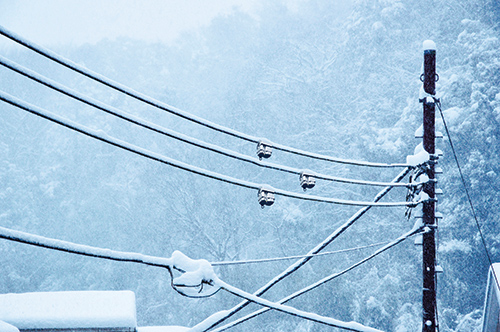Manitoba Hydro first started testing line sensors in 2006. We suspected that a number of stations on our distribution system were reaching capacity and might need upgrades, but we didn’t have consistent, quality data to support our planning decisions. The first sensors we used provided some useful data, but deployment and data collection from these devices was not easy. With the early sensors, we had to manually take them off the line and bring them back to the office to download the data. The next generation offered drive-by data collection which was better, but still a long process. These devices had their limitations. As the technology advanced, remote communication became available. But this required additional externally powered pole-mounted communications equipment that made deployment more expensive and less flexible. These line sensors were solar powered, which proved unreliable in northern locations like Manitoba, Canada.
In 2013, we decided get serious about understanding the potential of distribution line sensors. Manitoba Hydro needs to make informed decisions on capital investment for distribution station upgrades. We needed more consistent, quality, peak load data so we could accurately gage the risks associated with each station. We put out a general RFI to the industry and selected two vendors to pilot 318 sensors in both the urban and rural settings. Both vendor technologies offered three critical capabilities for rapid deployment: line power harvesting to avoid issues with dependable device powering; cellular communications to eliminate the need for additional communications infrastructure, and remote data hosting / support to obtain useable data without making an immediate investment in IT infrastructure.
By December of 2013 we had about 320 sensors deployed. Hotstick deployment, remote back office support, and line power harvesting made these devices easy to install and activate. We immediately began to see that the new sensors could offer a significant operational benefit in addition to load data for our planners. Prior to any switching operation, we now have load data to help ensure we are not overloading equipment. Essentially we can build an historical load curve database in near real time. Had we had this historical data in the past, we could have avoided previous outages due to phase imbalances and overloads.
There’s no better test than a real-life crisis
By January 2014 we were in the midst of one of our coldest and roughest winters in 40 years. On January 25, the temperature in Manitoba dropped to minus 30 degrees Celsius, and shortly after midnight, a rupture and subsequent fire occurred on TransCanada Corporation’s natural gas pipeline between Otterburne, Manitoba and Hwy 59 – about 80 km south of Winnipeg.
The affected TransCanada pipeline was one of two that supply the Manitoba Hydro natural gas distribution system in an area serving more than 4,000 natural gas customers. Although only one pipeline was severely damaged, the National Energy Board (NEB) and Transportation Safety Board (TSB) requested that TransCanada shut off the gas supply to the second pipeline as a safety precaution. Within about 12 hours, the gas line pressure would be near zero, and 4,000 customers would be left without natural gas heat for their homes, businesses, hospitals and nursing facilities. The arctic temperatures and near blizzard conditions would only make the bad situation worse.
In response, Manitoba Hydro activated its Emergency Operating Centre (EOC) to manage the gas event and monitor the electrical distribution load. What happens when 4,000 customers wake up to no heat and turn to electric space heaters or ovens to get relief from the bitter cold? If the extra load surpassed the capacity of the distribution system serving the area, it could cause outages which would greatly worsen the situation. We knew that some of the distribution lines could reach the critical point. Outages were not an option. We had to get load data from those lines as soon as possible to develop contingency plans.
We still had a dozen of the new sensors sitting in our office waiting to be deployed under better weather conditions. I and other crew members from Manitoba Hydro’s Distribution Engineering Services Department loaded them into a few trucks and headed for the critical substations in the affected areas. Before we left, we pieced together and alerted several line crews to meet us there, letting them know we were bringing the sensors. We also contacted our two vendors and told them we needed these sensors assigned and setup to send us load data every five minutes. And we needed this to happen as soon as the sensors where hung.
Nobody likes to do line work in high wind chills and minus 30°C temperatures. Fortunately the sensors install quickly. All we needed to do was hang them up and text the serial numbers to the appropriate vendors who were located as far away as San Francisco. A half-hour later, we had access to the load data in 5-minute intervals. By 5 PM all 12 sensors were remotely provisioned, live, and feeding data to Manitoba Hydro through the vendor web portals.

TransCanada Corporation was extremely professional in their response to the rupture, and service was fully restored within a few days. During that time, distribution line load reached near-capacity limits. Thankfully, the sensors allowed us to provide immediate situational awareness to our Emergency Operating Center, while monitoring and managing the event without experiencing outages or subjecting our customers to unnecessary disruptions in electric service.
Future deployment – the dilemma of the chicken and the egg
During our pilot program, we will continue to put sensors at stations which we believe could be nearing maximum load. Many of these stations are located in pockets experiencing high growth and development. This is going to be our challenge moving forward in a time where capital expenditures are under close scrutiny. Which locations do we spend our money on today, and which ones do we think we can defer to the future? The deployment of more sensors at additional locations would certainly help us make these decisions. Ironically, the capital required to purchase sensors competes with the capital to deploy the IT infrastructure that will optimize the value of the data they provide. It’s the classic ‘chicken and egg’ dilemma.
There is no question that this new generation of advanced distribution line monitor/sensors can add significant value for both our Operations and Distribution Engineering teams. The historical data on peak load has already helped us make better operational and investment decisions. And we’ve only scratched the surface on the value of the ‘Communicating Faulted Circuit Indicator’ (cFCI) technology some of these sensors provide. But the real value will come when we can transform this data into actionable intelligence that can get to our field crews in near real time. That’s only going to happen with investment in the proper IT infrastructure such as an OMS or DMS. We are at the point where we have hired Siemens to create an implementation roadmap to identify and understand the value and best timing of these investments to maximize ROI.
Debating network communications and data hosting
Another consideration we wrestle with for future sensor rollout is data communications infrastructure. All the sensors in our pilot program communicate via cellular modems, but cellular charges adds to our annual O&M expenditures, which is always under scrutiny. The advantage we saw for cellular was quick deployment, minimal capital investment, and end-to-end support from the vendors. Developing our own communications infrastructure to service AMI or developing the utilities 1.8 GHz wi–max system is still some time away, so our options were limited. In addition, dependable cellular coverage is only available in about 30 percent of our service territory. To address the cellular shortcomings, we are currently working with the California based vendor to test range extender units that would allow us to expand sensor deployments to areas with spotty cellular service.
Data hosting enabled us to implement this technology without immediate investment in IT infrastructure and operational support. It also allowed us to understand the complexity of the technology with full support from the vendors. Whether we bring this technology in-house or continue to have it hosted, will for now, depend on operational costs and internal resources available to support it. The pilot has definitely challenged some of our assumptions in terms of understanding this type of technology and highlighted a number of processes which need to be addressed before a larger scale implementation can occur.
We will look to our implementation roadmap to help us decide when and where we expand deployment of these sensors. But based on the initial pilots, there is little question that if the data they provide is fully utilized, the result will be better operational efficiency for Manitoba Hydro and better reliability for our customers.
About the Author
 Graham Eason is a Certified Engineering Technologist (C.E.T.) for Distribution Performance Engineering at Manitoba Hydro. He has been employed for more than 25 years starting his career at Manitoba Hydro as a protection technician on the transmission system, and then moved to distribution in 2002. He is currently charged with reliability improvement initiatives and piloting new technologies on the utility’s distribution system. Graham has been involved in the Distribution Roadmap initiative since 2006, and continues to be involved with the current Siemens Compass initiative Manitoba Hydro is undertaking.
Graham Eason is a Certified Engineering Technologist (C.E.T.) for Distribution Performance Engineering at Manitoba Hydro. He has been employed for more than 25 years starting his career at Manitoba Hydro as a protection technician on the transmission system, and then moved to distribution in 2002. He is currently charged with reliability improvement initiatives and piloting new technologies on the utility’s distribution system. Graham has been involved in the Distribution Roadmap initiative since 2006, and continues to be involved with the current Siemens Compass initiative Manitoba Hydro is undertaking.







